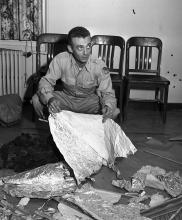Listen to today's episode of StarDate on the web the same day it airs in high-quality streaming audio without any extra ads or announcements. Choose a $8 one-month pass, or listen every day for a year for just $30.
You are here
Wilhelm Roentgen
It’s not unusual for a husband to take a picture of his wife displaying her wedding ring. Until Wilhelm Roentgen came along, though, none had taken a picture of not just the ring, but of the bones beneath it. Roentgen had just discovered X-rays — a form of light that can pass right through many substances, including human flesh. The shot of his wife’s hand — including her ring — was the first X-ray image.
Roentgen was born 175 years ago today, in Germany. His family moved to the Netherlands when he was three. He developed an interest in the outdoors, and in building mechanical devices. But he also wanted to learn how the universe works, so he earned a PhD in physics in Switzerland.
In 1895, Roentgen was studying a form of energy that’s produced when an electric charge is passed through a vacuum tube. He put his test rig inside a black box, which was in a dark room. When he set if off, though, it caused a light-sensitive screen a few feet away to glow.
Roentgen decided that his equipment was producing a new form of rays. He called them X-rays, although others called them Roentgen rays.
Scientists found a way to put those rays to work. Eventually, that included astronomers, who study X-rays produced by objects in the sky. The list includes the remnants of exploded stars, disks of hot gas around black holes, and clouds of gas around clusters of galaxies. The observations help astronomers “diagnose” how these objects work — thanks to X-rays.
Script by Damond Benningfield





